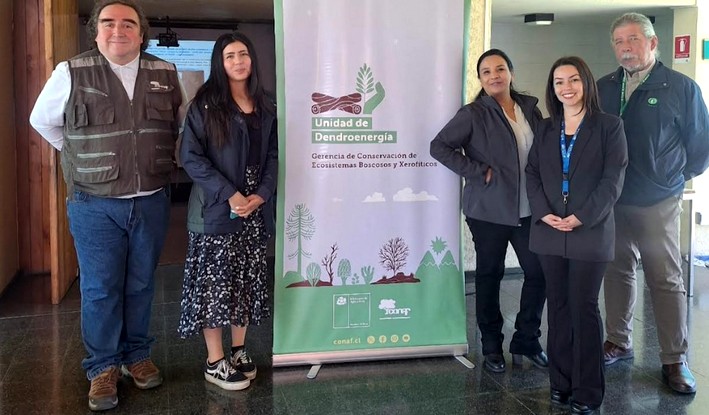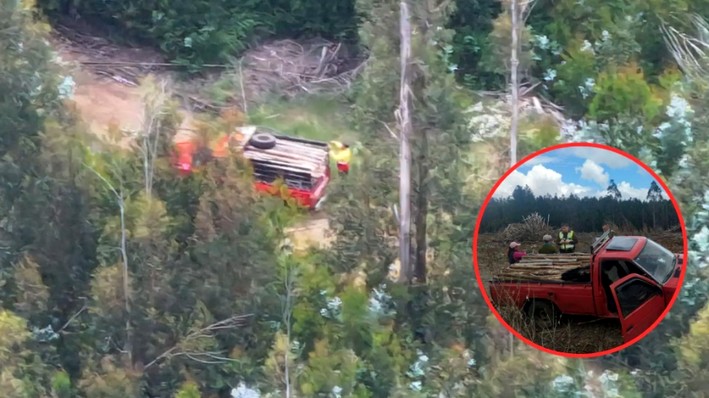Nine fires in 42 days on the same property: The pattern of intentional burns to usurp land in the south
From November 6 to December 18, 2024, the "Pehuén" forest property was burned nine times. Due to these events, Forestal Arauco, the owner of the land, filed a complaint earlier this year, arguing that the frequency of the incidents and the way they started and spread led them to conclude "that we are facing repeated illegal acts of intentional fires."
The property is located between the communes of Lebu and Los Álamos in the Biobío Region, where Senapred declared a Red Alert for forest fires on the night of February 13. That day, around 50 hectares burned in the commune as a result of five fires, some nearly simultaneous, in areas such as Villa Bosque Sur, Playa Millaneco, and Caleta Millongue.
Although the incidents reported by Forestal Arauco occurred at the end of 2024, 2025 has been complex in the surroundings of where the repeated fires in Pehuén took place: on February 13 itself, there was another fire on that property.
Forestal Arauco's complaint explains that the nine fires occurring within 42 days are linked, on one hand, to logging to steal wood and, on the other, to cutting and burning trees to clear land intended for usurpation. "All of this is evident from the fact that multiple outbreaks occur on the same day in different sectors of the specified property," the document states.
According to René Muñoz, manager of the Association of Forestry Contractors, land usurpations in forest properties are a state problem due to the housing deficit and because "the Ministry of Housing does not function, and the Regional Government does not care about zoning plans." To this, he adds impunity.
"It's a vicious cycle that makes this issue grow because nothing happens to those responsible (...). Who is in prison today for arson? If you add to the issue of usurpations, the municipalities, the regional governments, and the Ministry of Housing, the fact that burning is free... We have the experience of our equipment being burned repeatedly, and out of nearly 500 attacks, only three have been resolved—three. The same happens with these types of fires. Prosecutors don’t know how to investigate; they’re not trained for this. That’s why we raised as an observation in the fire prevention bill currently in the Senate Agriculture Committee that more authority and better conditions must be given to the police and prosecutors so they can achieve some outcome," says Muñoz.
Muñoz explains that in cases where arrests have been made, "mental health issues are usually cited, sentences are reduced or commuted, and we end up with no one in prison."
Debate on the new fire prevention law
Regarding legal tools, Muñoz refers to the forest fire prevention and mitigation bill currently in the Senate. The initiative has faced criticism from the forestry sector.
Muñoz points out that the criticism stems from the bill "saying nothing about intentionality, nothing about dedicated prosecutors, nothing about mixed patrols during these extraordinary events. So, we’re stuck in a serious problem where the state is unable to provide anyone with the tools to solve this."
The forestry contractors' leader adds, "There are crazy and heartless people everywhere, and pyromaniacs are everywhere too. What we need to do today is attack that focus—intentionality is where we must direct efforts, where legislators must direct efforts. But the new bill doesn’t establish any of that, which is why we’re against it; that’s why we say it’s a bad law."
Usurpations in firebreaks
Ramón Figueroa, Arauco’s Deputy Manager of Fire Protection, explains that this is a pine forest, but there are also other tree species, shrubs, and bushes. The modus operandi of those seeking to usurp these lands involves burning the fields, after which "the trees die standing, and then in winter they cut the wood and sell dry wood for firewood. Later, they clear those lands, settle in, and start selling them, even though they’re not the owners."
Figueroa notes that to date, they have 1,200 hectares of forest taken over in areas like Curanilahue, Cerro Alto, Los Álamos, and Lebu. "Therefore, the goal is to identify those responsible for the fires, who later, after cutting the wood, steal it and start selling the land to third parties to install makeshift housing," he says.
Figueroa recalls the February 1 attack on a helicopter working to combat a fire. That day, unknown individuals carrying long firearms shot at the aircraft, hitting the fuselage. Arauco’s Deputy Fire Protection Manager notes that this incident occurred very close to the Pehuén sector where the repeated fires took place. He recounts that before the helicopter shooting, Carabineros were on-site because people were stealing wood—officers managed to detain some of those involved, but others escaped. "An hour and a half later, they started a fire on the same property," he says.
He adds that in the area, besides stealing wood, they were setting up makeshift housing in the firebreak: "The firebreak is meant to protect people, but these individuals end up turning it into an illegal housing occupation, deactivating the firebreak."
Specifically, in Pehuén, the fires began at 5:36 PM on November 6, 2024—flames that could not be extinguished until the afternoon of the next day. Subsequently, fires occurred on November 8, 14, and 17. On those days, the fires started at night when aircraft cannot operate and when there is no sunlight that could ignite a fire through a magnifying glass effect. For example, on November 8, the fire started at 12:08 AM and was not extinguished until 9:21 AM the same day. On November 14, it began at 9:21 PM, and on November 17 at 10:20 PM. In those two instances, the fires consumed part of the pine forest over 14 years old.
Damage to the Pehuén property
Meanwhile, in December, multiple fires occurred on the same day. On December 16, there were two: the first at 5:57 PM, extinguished by 7:56 PM the same day, and the second in a different location at 8:44 PM, lasting until 9:12 PM. Something similar happened on December 17. That day, the first fire started in the early morning at 3:27 AM and was extinguished two hours later; the second occurred at 10:21 PM.
The last of the nine successive fires was on December 18 and lasted over 24 hours. It started at 10:24 PM on the 18th and was not extinguished until 11:42 PM on December 19.
Figueroa states that they see this type of situation every year. He even recalls extreme cases like the property in Los Álamos, San Ambrosio, where 173 fires were recorded in a single fire season.
On the matter, Figueroa notes that in recent years, the Maule Region has had 42 successful cases where those responsible for the fires were identified. However, he emphasizes that Maule "has more success than all other regions combined."
"In Chile, less than 1% of fire complaints lead to identifying those responsible. In contrast, in countries like Spain, it’s 23%. Clearly, something isn’t working here. What they do in Maule is somewhat like what’s done in Europe: as soon as a fire starts, police investigate immediately—not days, weeks, months later, or never. And second, investigative measures include all available technology—phone interceptions, cell tower positioning, etc. Other prosecutor’s offices don’t do that, or they do it weeks or months later when evidence is practically gone," adds Figueroa.
Regarding the Prosecutor’s Office’s actions, Agriculture Minister Esteban Valenzuela stated on Monday that he would speak with National Prosecutor Ángel Valencia, as in Biobío, there is a proposal from the Disaster Risk Management Committee (Cogrid) to have a prosecutor dedicated exclusively to investigating fires in the region.
Source:El Libero

















